Maintaining a sparkling clean bathtub can be quite the task, especially if you’re dealing with persistent dirt and grime. Over time, soap scum, mildew, and mold can cling to the surfaces, turning your relaxing space into an unsightly area. However, with a few clever cleaning hacks, tackling these unwelcome elements becomes less daunting. By understanding the right techniques and substances to use, you can effectively remove even the most stubborn stains, ensuring your bathtub retains its pristine appearance with less effort.
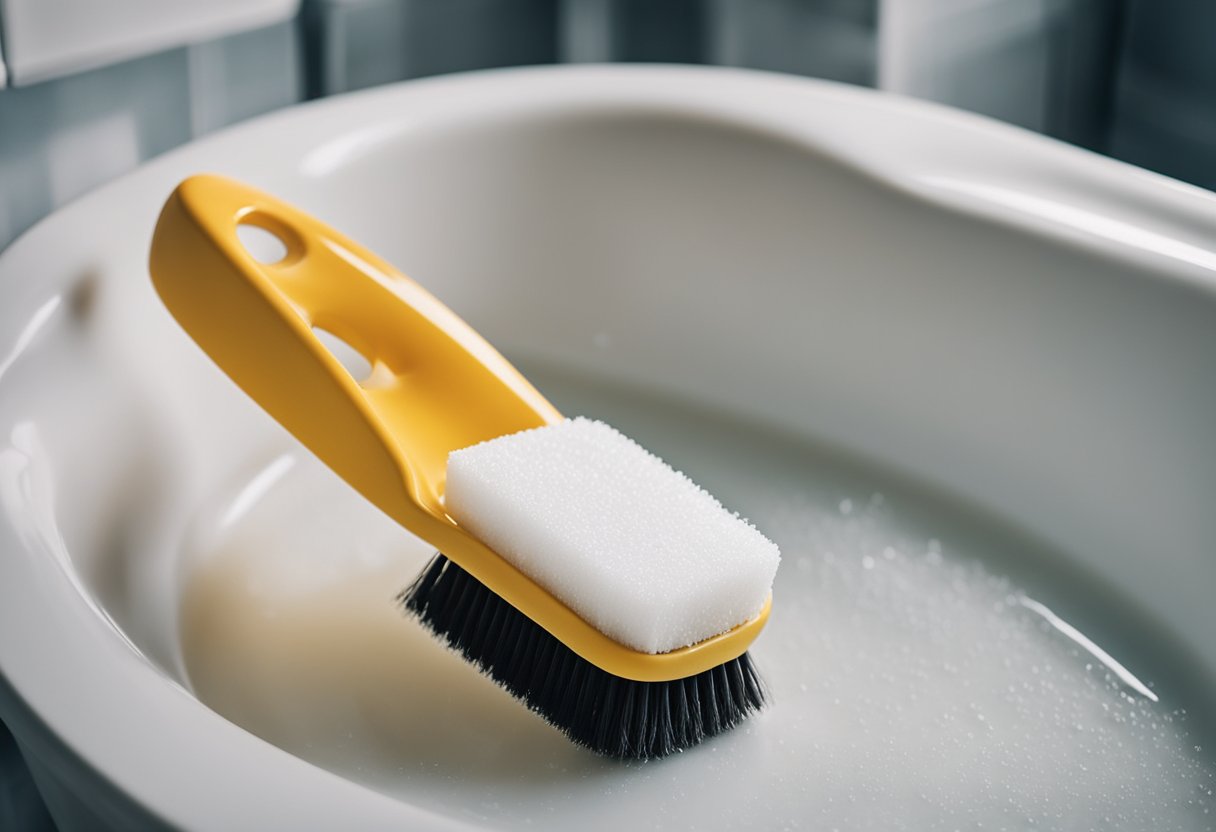
The key to efficient bathtub cleaning lies in the regularity and the tools at your disposal. It might surprise you to learn that some of the most effective cleaning agents can be found right in your kitchen or bathroom cabinets. From harnessing the natural abrasive power of baking soda to the stain-dissolving capabilities of vinegar, these everyday items can be powerful allies. By using them correctly, you can cut through soap scum and eradicate mold and mildew, leaving your tub looking and smelling fresh.
Furthermore, understanding when to employ a gentle touch or when to apply some elbow grease can make a significant difference. Not all buildup is created equal; some areas may require a more patient approach, while others need immediate and vigorous action to prevent long-term damage. Implementing these cleaning hacks not only keeps your bathtub in top condition but also saves you time for more enjoyable activities. With a little know-how and the right approach, you’ll be equipped to maintain a bathroom that feels both clean and inviting.
Preparation and Safety Measures
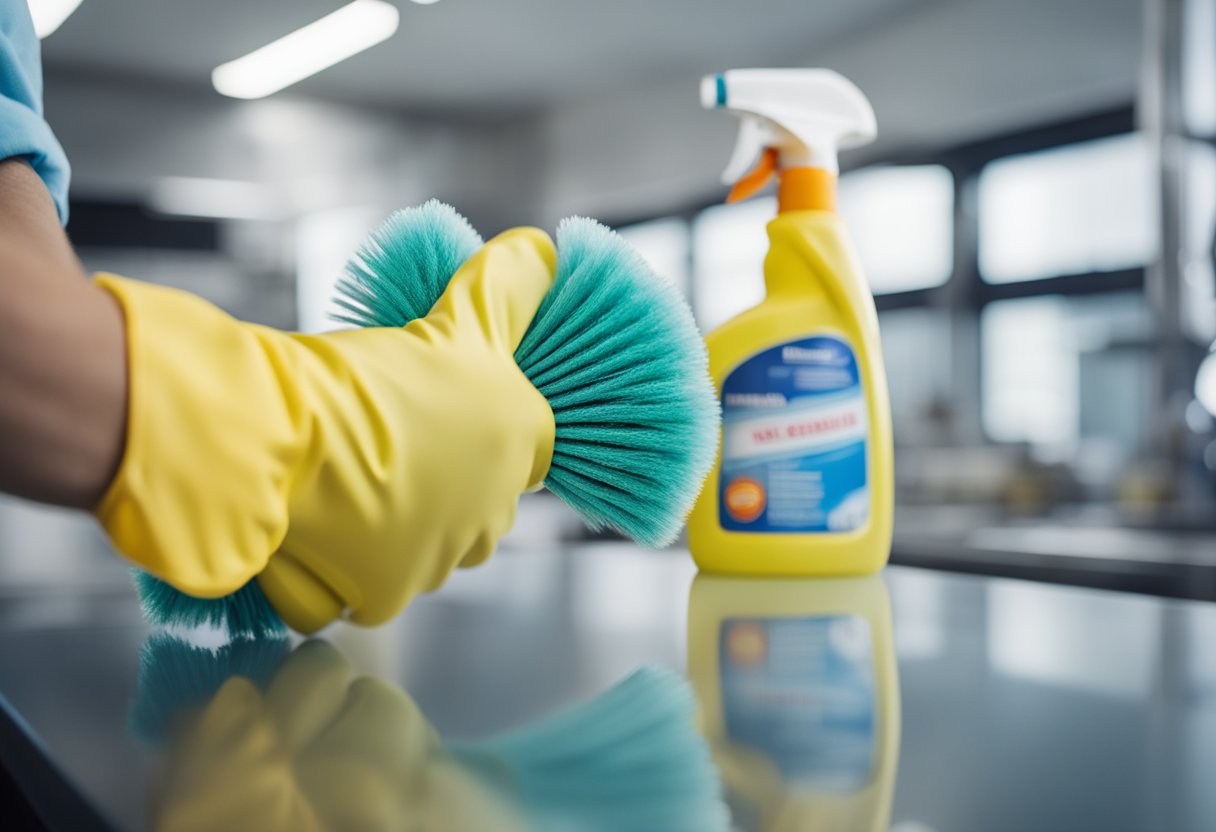
Efficient bathtub cleaning starts with the right preparation and safety measures in place. By gathering essential supplies and ensuring personal safety, you reduce the risk of accidents and improve cleaning efficiency.
Gathering Essential Cleaning Supplies
You will need the following items:
- Rubber gloves: To protect your hands from cleaning agents.
- Safety glasses: To shield your eyes from splashes.
- Baking soda: A mild abrasive for scrubbing without scratching.
- Vinegar: An effective, natural descaling agent.
- Bucket: For mixing cleaning solutions and rinsing.
- Sponge and scrub brush: To apply cleaners and remove dirt.
Having all your supplies ready can streamline the cleaning process and prevent delays.
Ensuring Personal Safety
Personal safety is paramount when cleaning your bathtub. Follow these guidelines:
- Wear rubber gloves to protect your hands from harsh chemicals or irritants.
- Use safety glasses to prevent cleaning agents from splashing into your eyes.
- Ensure the room is well-ventilated to avoid inhaling fumes from cleaning products.
Remember to read all labels on cleaning agents for any additional safety instructions specific to the products you are using.
Routine Cleaning Techniques
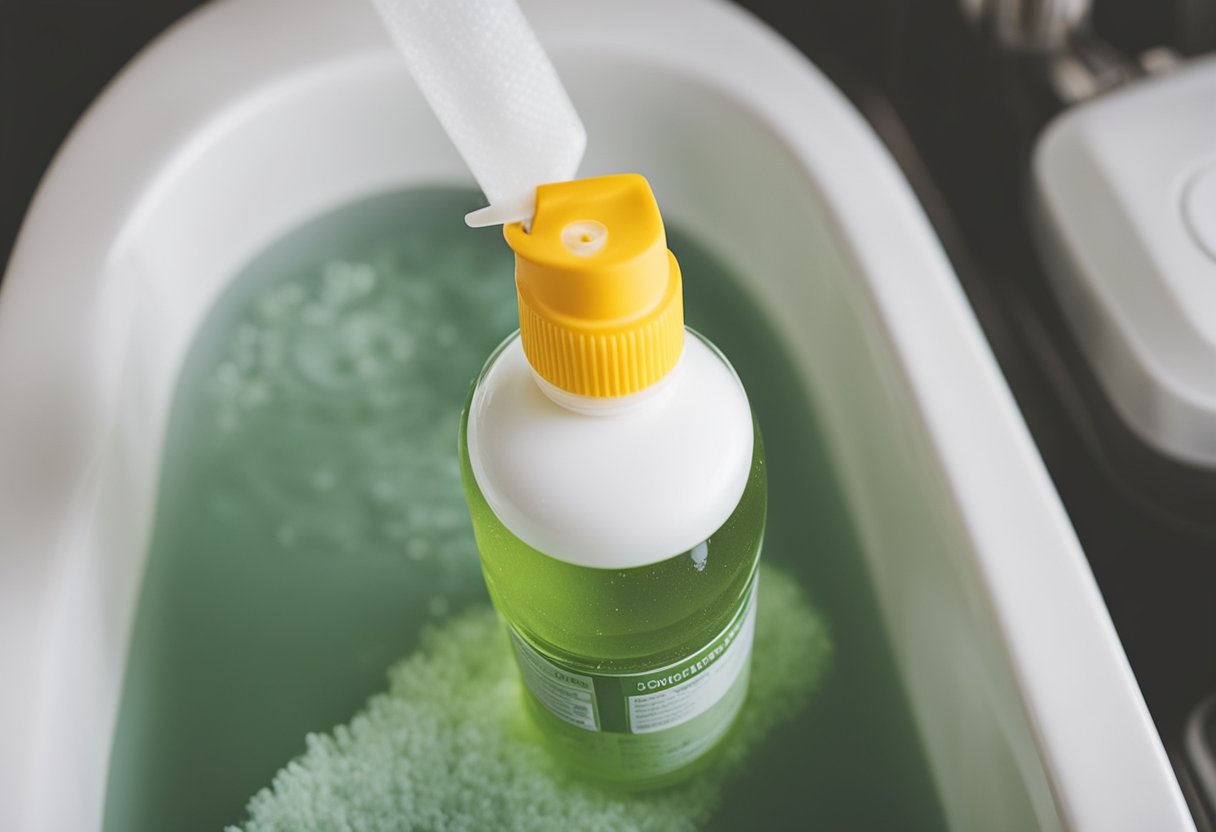
Proper maintenance can prevent soap scum build-up and mildew in your bathtub. Regular cleaning preserves the shine and ensures hygiene in your bathroom.
Daily Maintenance Habits
For daily upkeep:
- Use Warm Water: After each use, rinse the bathtub with warm water to wash away any residue.
- Wipe Surfaces: Using a microfiber cloth ensures a quick and effective removal of water droplets and prevents mineral deposits.
Weekly Bathtub Cleaning Steps
Adopt a weekly deep-clean routine to keep your bathtub looking new:
- Prepare Your Supplies: Gather a non-abrasive bathtub cleaner, a microfiber cloth, and warm water.
- Apply Cleaner: Spread the cleaner evenly over the tub surface, making sure to cover all areas.
- Scrub Gently: With a soft brush, scrub the tub’s surface in a circular motion, focusing on any mildew or stains.
- Rinse Thoroughly: After scrubbing, rinse the tub with warm water to wash away any remaining soap and debris.
- Dry: Use a clean microfiber cloth to dry the bathtub to prevent water spots.
Regular cleaning with the right techniques and tools ensures a sparkling, well-maintained bathtub.
Dealing with Specific Problems
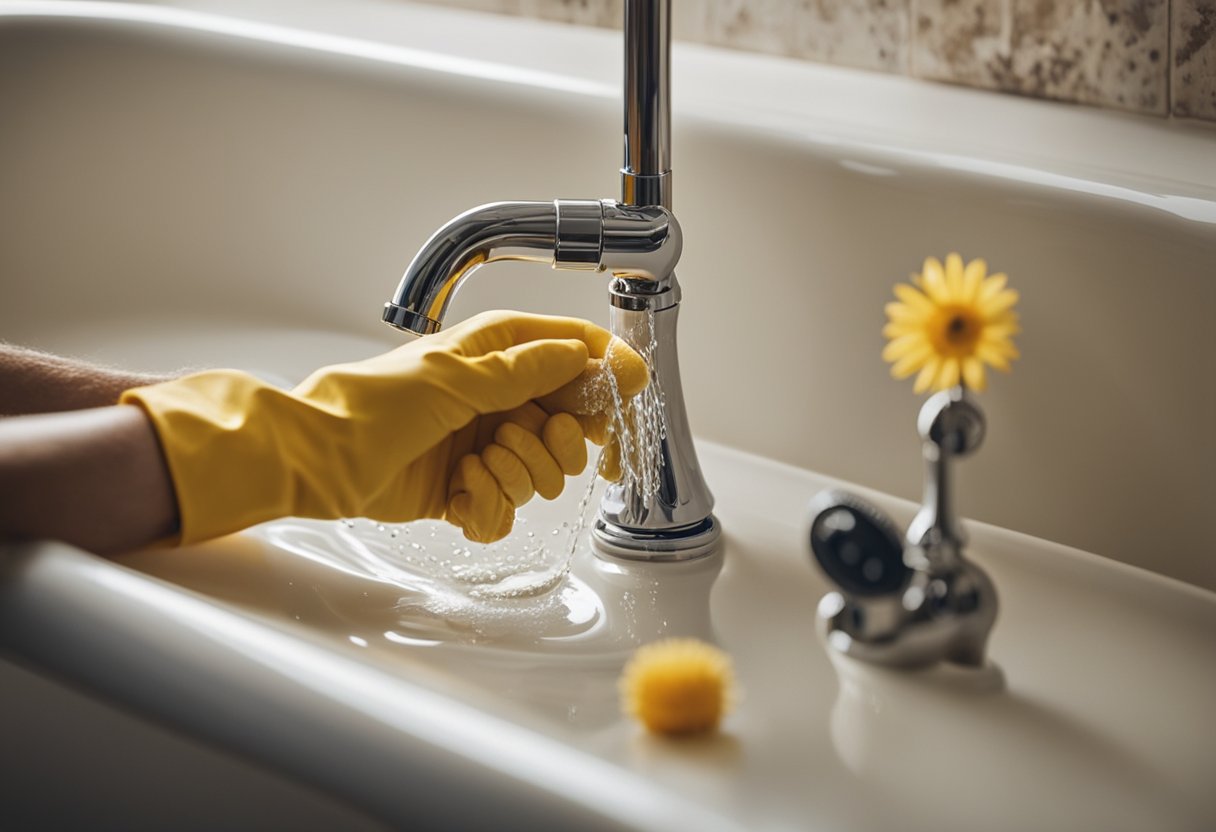
When tackling specific issues in your bathtub, like stubborn stains and persistent mold, the right approach and use of effective substances can make a significant difference.
Removing Tough Stains and Scum
To remove tough stains and soap scum, you’ll want to use a mixture that can break down the minerals and grime. For hard water stains, try this:
- White vinegar and baking soda: Create a paste with equal parts of white vinegar and baking soda. Apply this to the stained area, leave it for 15 minutes, then scrub with a non-abrasive brush or sponge and rinse.
For soap scum:
| Method | Directions |
|---|---|
| Hydrogen peroxide | Apply directly to the scum, allow it to sit, then scrub and rinse. Ideal for lighter stains. |
| Bleach (use with caution) | Dilute bleach with water (1 part bleach to 2 parts water), apply, wait 10 minutes, scrub and rinse thoroughly. Wear gloves and ensure good ventilation. |
Addressing Mold and Mildew
Mold and mildew require immediate attention as they not only appear unsightly but can also pose health risks.
- Use a solution of 1 part bleach to 10 parts water to treat and disinfect the affected areas. Apply the solution, let it sit for at least 10 minutes, then scrub with a soft-bristled brush and rinse.
- For non-bleach alternatives, hydrogen peroxide is an effective option. Apply it directly to the mold or mildew, let it rest for a few minutes, and then scrub and rinse away.
Remember to always wear protective gloves and ensure the room is well-ventilated when using strong cleaning agents.
Natural and Non-Toxic Alternatives
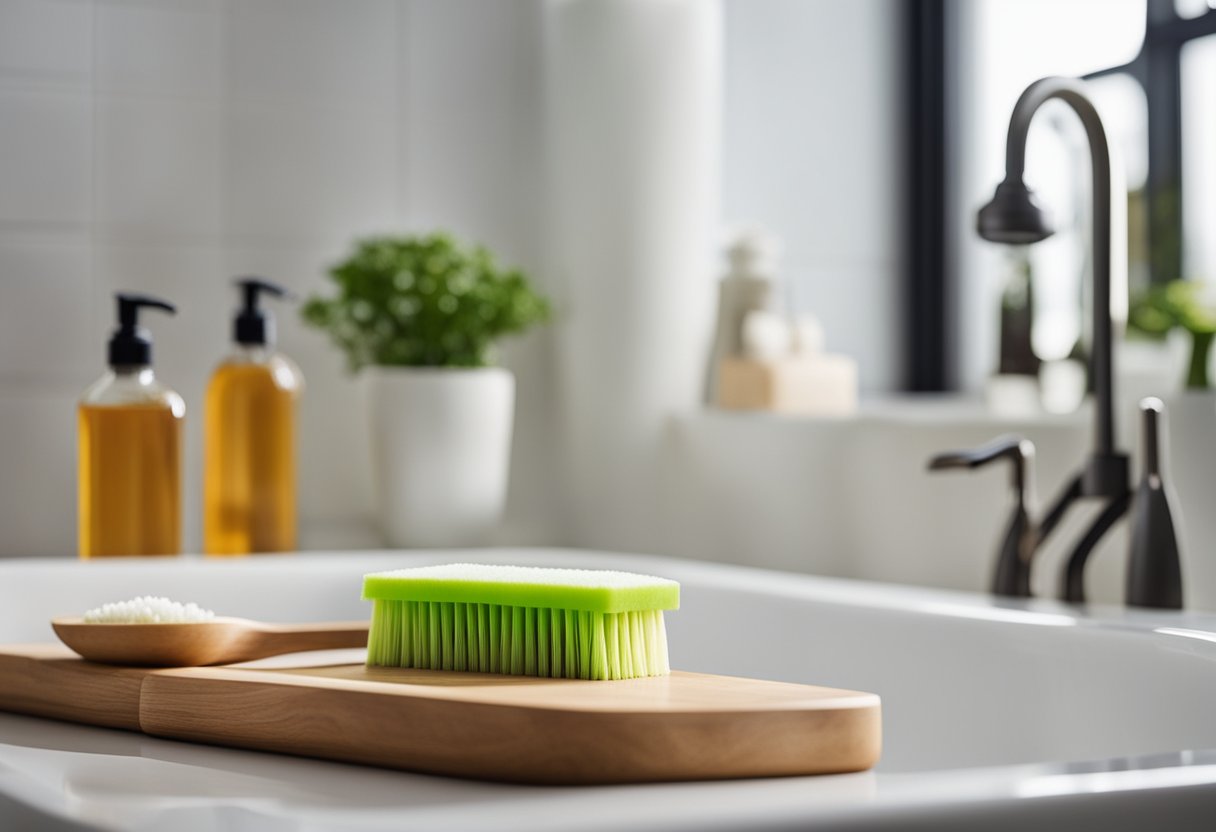
Natural methods are not only safer for your health and the environment, but they can also be surprisingly effective at tackling bathtub grime. Utilizing common household items like baking soda and vinegar, coupled with the natural cleaning power of lemon juice and essential oils, you can maintain a sparkling clean bathtub without the need for harsh chemicals.
Using Baking Soda and Vinegar
Baking Soda: A mild abrasive, which, when applied to your bathtub, can help remove tough stains without scratching the surface. To use it effectively:
- Sprinkle baking soda generously over the surface of the bathtub.
- Scrub the area with a damp cloth or sponge, forming a paste as you clean.
- Rinse the surface thoroughly with water afterward.
White Vinegar: An excellent natural disinfectant and deodorizer. For a deeper clean:
- Combine equal parts of white vinegar and warm water in a spray bottle.
- Spray the solution directly onto the bathtub surfaces and let it sit for 15 minutes.
- After the solution has done its work, scrub lightly with a sponge or brush, then rinse.
Combining Both: For challenging grime,
- First, apply the baking soda.
- Follow by spraying the vinegar and water mixture.
- Allow the reaction to fizz and break down the stains before scrubbing.
- Rinse with water for a clean finish.
Leveraging Lemon Juice and Essential Oils
Lemon Juice: The natural acidity in lemon juice makes it great for dissolving soap scum and water spots. Apply it by:
- Cutting a lemon in half and rubbing it directly on the affected areas.
- Let it sit for a few minutes and then rinse well.
Essential Oils: When added to your cleaning solutions, essential oils can provide antibacterial properties and a pleasant scent. Add several drops of your favorite essential oil to the above vinegar solution for an aromatic cleaner.
By incorporating these simple, natural ingredients into your cleaning routine, you can achieve a clean and fresh bathtub while avoiding the potential risks associated with synthetic cleansers.
Frequently Asked Questions

This section addresses common queries about maintaining a clean and hygienic bathtub using a variety of methods and products.
What are the most effective products to use for a sparkling clean bathtub?
For a sparkling clean bathtub, use a combination of bathroom-specific cleaners that are formulated to tackle soap scum and hard water deposits. Natural alternatives like distilled white vinegar and baking soda are also highly effective.
What techniques can I use to clean my bathtub without the need for scrubbing?
Apply a cleaning solution and let it sit for 15-20 minutes. This allows the chemicals or natural agents to break down the dirt, making it easier to rinse off without scrubbing.
What is the best method to remove old stains from a bathtub?
To remove old stains, create a paste using hydrogen peroxide and cream of tartar, apply it to the stain and let it sit before rinsing. For tougher stains, let the paste sit for a couple hours or overnight.
How can I disinfect my bathtub without resorting to bleach?
Disinfect your bathtub without bleach by using hydrogen peroxide or a mixture of vinegar and baking soda. Allow the solution to sit for at least 30 minutes before rinsing for effective disinfection.
What are the steps to clean a bathtub using baking soda?
Sprinkle baking soda liberally around the tub. Wet a sponge and scrub gently. After scrubbing, let it sit for a few minutes, then rinse the tub with clean water for a non-toxic clean.
How can I achieve a whiter bathtub if it has become discolored over time?
For whitening a discolored bathtub, combine equal parts of baking soda and cream of tartar with lemon juice to form a paste. Apply it to the affected areas, leave it for 30 minutes, then rinse and wipe clean.
